
Temple Grandin with WA agriculture minister Alannah MacTiernan and Harvest Road’s Nicola Forrest
WORLD renowned animal behaviourist Professor Temple Grandin visited Western Australia last week, providing guidance over animal handling facilities for a major new integrated beef supply chain project currently in its early stages of development.
Twiggy Forrest’s Harvest Road Group, which owns and operates the Harvey beef processing facility near Harvey in the state’s southwest, and a string of cattle properties under the Minderoo flag further north, hosted Prof Grandin’s visit.
Dr Grandin is advising Harvest Road on plans for its newly acquired site at Koojan Downs, near Moora, 170km north of Perth. The group is developing a large-scale feeding facility on the site, which plans to produce premium WA beef for domestic and export markets.
Harvest Road plans to spend up to $50 million developing an integrated backgrounding and intensive grainfeeding business, designed to even-out seasonal cattle supply to the company’s Harvey Beef processing plant.
The project is centred around a series of recently-acquired mixed farming properties totalling about 7000ha at Koojan, near Moora in the central midlands wheatbelt district.
The first phase of the development will accommodate 40,000 cattle at a time, with a view to supplying about 60,000 100-day grain-finished cattle each year to the Harvey processing facility. A proposed second phase would double that capacity, the company said during the project’s launch in December (click here to view earlier Beef Central story).
Harvest Road is part of Twiggy Forrest’s Minderoo Group, one of Australia’s largest private investment vehicles. Its portfolio of agricultural investments covers 1.3 million hectares of pastoral land on five properties in the state’s north; the Harvey Beef processing business; and a range of fine food brands targeting domestic and international markets, with exports to more than 30 countries.
Harvest Road Group chief executive Greg Harvey said the new Koojan project would involve both cattle backgrounding and an ‘intensive feeding’ system, which it said would include some features significantly different in stock-density and design from conventional feedlots.
Instead, the company has chosen to use terms like ‘free range, intensive feeding’. It said the new model would provide cattle with significantly more ‘freedom to move’ than the current grainfed industry standard, and ‘more focus’ on animal welfare.
Harvest Road said the philosophy of the Koojan facility would be built on the innovative cattle husbandry practices of Dr Grandin, whose methods are recognised globally and deliver significant improvements to animal welfare.
Last week, Dr Grandin visited the Harvest Road facilities, observed livestock and met with employees.
“It has been a pleasure to visit Western Australia and see Harvey Beef’s supply chain at work,” Dr Grandin said.
“It is clear that a passion for animal welfare drives the work of this organisation, from farmer to producer to customer,” she said.
Minderoo co-founder Nicola Forrest spent time with Dr Grandin during her visit and said she was inspired by her insights.
“It was our pleasure to host Temple during her whirlwind trip to WA,” Ms Forrest said. “Her passion for animal welfare is inspiring, and we are thrilled she is advising us on the way forward for Koojan.”
Harvest Road Group’s general manager of livestock and agriculture, Kim McDougall looked forward to the opportunity to continue to work closely with Dr Grandin.
“We want the Koojan facility to be a world leader in animal welfare,” he said. “Temple’s knowledge of animals and their needs is second to none, and we’re looking forward to learning from her.”
It is anticipated that the Koojan Downs facility will be operational in 18 months, and Prof Dr Grandin will continue to advise Harvest Road as work on the new facilities continues.
Prof Grandin’s visit coincided with celebrations marking the one-hundredth anniversary of commencement of operations for Harvest Road’s Harvey Beef processing facility, the state’s largest beef plant, established in 1919.

Joining Temple Grandin in cutting a birthday cake marking 100 years of operations for Harvey Beef in WA were from left, Greg Harvey, CEO of Harvest Road Group, WA ag minister Alannah MacTiernan and Harvest Road’s Nicola Forrest.

Agreed Patrick , the NFAS standard is 25m2 as maximum area allowed per beast , it’s there for a reason . If you exceed this maximum area you won’t meet accreditation requirements, most feedlots run from 9-13 m2 per beast to aid with dust suppression which in turn reduces the incidence of BRD which is the biggest cause of lost performance in any feedlot
Harvest Road’s Koojan project involving a ‘free range, intensive feeding’ system might sound like it has advantages over lotfeeding, but the reality is likely to be different. National Feedlot Accreditation Scheme feedlots have a long history of looking after cattle welfare and the environment. Similarly pasture raised and finished cattle is usually undertaken with responsible animal welfare and environmental management. The same cannot be said for so-called hybrid cattle finishing system referred to as a “free range, intensive feeding system… which provide cattle with significantly more freedom to move.” This system is likely to run into significant environmental issues especially during exceptionally wet and exceptionally dry times when paddock stocking rates far exceed paddock carrying capacities. With thousands of free-range cattle on-hand so called pasture paddocks can become quagmires or dustbowls. And in the paddocks where ‘free-range intensive feeding’ is taking place what happens to the tonnes of water soluble phosphates and nitrates generated by “…60,000, 100-day grain finished cattle each year”?
Pat Francis is a former editor of Australian Farm Journal, and a Victorian beef producer. Editor
Harvest Road continue to lead by example in world class Beef production. Well done.